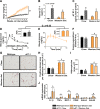Overproduction of endothelin-1 impairs glucose tolerance but does not promote visceral adipose tissue inflammation or limit metabolic adaptations to exercise
- PMID: 31310581
- PMCID: PMC6766607
- DOI: 10.1152/ajpendo.00178.2019
Overproduction of endothelin-1 impairs glucose tolerance but does not promote visceral adipose tissue inflammation or limit metabolic adaptations to exercise
Abstract
Endothelin-1 (ET-1) is a potent vasoconstrictor and proinflammatory peptide that is upregulated in obesity. Herein, we tested the hypothesis that ET-1 signaling promotes visceral adipose tissue (AT) inflammation and disrupts glucose homeostasis. We also tested if reduced ET-1 is a required mechanism by which exercise ameliorates AT inflammation and improves glycemic control in obesity. We found that 1) diet-induced obesity, AT inflammation, and glycemic dysregulation were not accompanied by significantly increased levels of ET-1 in AT or circulation in wild-type mice and that endothelial overexpression of ET-1 and consequently increased ET-1 levels did not cause AT inflammation yet impaired glucose tolerance; 2) reduced AT inflammation and improved glucose tolerance with voluntary wheel running was not associated with decreased levels of ET-1 in AT or circulation in obese mice nor did endothelial overexpression of ET-1 impede such exercise-induced metabolic adaptations; 3) chronic pharmacological blockade of ET-1 receptors did not suppress AT inflammation in obese mice but improved glucose tolerance; and 4) in a cohort of human subjects with a wide range of body mass indexes, ET-1 levels in AT, or circulation were not correlated with markers of inflammation in AT. In aggregate, we conclude that ET-1 signaling is not implicated in the development of visceral AT inflammation but promotes glucose intolerance, thus representing an important therapeutic target for glycemic dysregulation in conditions characterized by hyperendothelinemia. Furthermore, we show that the salutary effects of exercise on AT and systemic metabolic function are not contingent on the suppression of ET-1 signaling.
Keywords: adipose tissue; endothelin-1; exercise; glucose control; inflammation.
Conflict of interest statement
No conflicts of interest, financial or otherwise, are declared by the authors.
Figures




References
-
- Barhoumi T, Briet M, Kasal DA, Fraulob-Aquino JC, Idris-Khodja N, Laurant P, Paradis P, Schiffrin EL. Erythropoietin-induced hypertension and vascular injury in mice overexpressing human endothelin-1: exercise attenuated hypertension, oxidative stress, inflammation and immune response. J Hypertens 32: 784–794, 2014. doi:10.1097/HJH.0000000000000101. - DOI - PubMed
Publication types
MeSH terms
Substances
Grants and funding
LinkOut - more resources
Full Text Sources
Molecular Biology Databases

